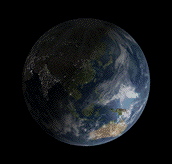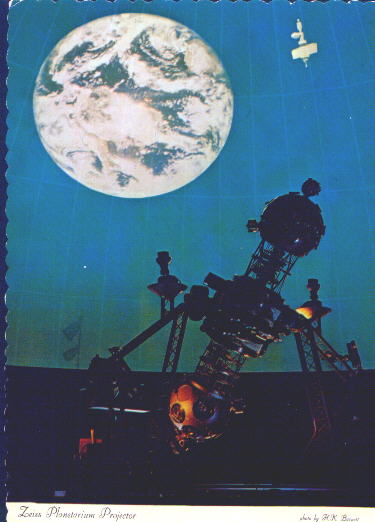
The northern polar regions remain dark, while the southern regions of Earth bathe through 24 hours of sunshine on 2007 December 22 in celebration of the Northern Hemisphere Winter Solstice.
(Image Source: Wikipedia.org )
By Glenn A. Walsh
Reporting for SpaceWatchtower
The season of Winter officially begins in the Northern Hemisphere of Earth, at the moment of the Winter Solstice, early on Sunday Evening, 2014 December 21 at 6:03 p.m. Eastern Standard Time (EST) / 23:03 Coordinated Universal Time (UTC). A day later, the annual Ursid Meteor Shower peaks, which can also be viewed on a live, Internet Web-Cast on the evening of December 22.
Winter Solstice 2014
In etymology, the word solstice comes from the Latin terms sol (Sun) and sistere (to stand still). In ancient times, astronomers / astrologers / priests recognized that one day of the year the Sun would appear to reach its lowest point in the sky for the year. The motion of the Sun's apparent path in the sky (what is known astronomically today as the Sun's declination) would cease on this day, before reversing direction.
With our current Gregorian Calendar, this usually occurs on, or very close to, December 21. In ancient times, when people used the Julian Calendar, the Winter Solstice occurred on, or very close to, December 25, what we now know as Christmas Day. Mid-Winter festivals, at the time of the Winter Solstice, were common in ancient times. Instead of competing with these traditions, the early Roman Catholic Church christianized the Winter festivals by observing the birth of Jesus Christ on December 25 (the actual birth date probably occurred in August or September).
Today, we know that, while the Sun does have motions, it is actually the motion of the Earth, tilted on its axis 23.44 degrees while revolving around the Sun, that causes the Earth's seasons. Hence, as the Earth arrives at the point in its orbit around the Sun, when the south polar axis is most directly inclined toward the Sun (thus, the Sun appears at its lowest point for the year in the Northern Hemisphere sky), this marks the Winter Solstice in the Northern Hemisphere (and the Summer Solstice in the Southern Hemisphere).
Alternately, the Summer Solstice marks the beginning of Summer in the Northern Hemisphere (and the Winter Solstice begins Winter in the Southern Hemisphere) when the Earth reaches the point in its orbit when the north polar axis is most directly inclined toward the Sun.
Although the Winter months in the Northern Hemisphere are known for the year's coldest weather, the Earth is actually at the point in its orbit closest to the Sun (astronomically known as the point of perihelion) on or very near January 2. The Earth is farthest from the Sun, each year shortly after the Northern Hemisphere's Summer Solstice, on or very near July 5 (the point of aphelion).
Solar radiation, and hence heat from the Sun, depends on the length of daylight and the angle of the Sun above the horizon. The tilt of the planet's axis toward the Sun determines the additional and more direct solar radiation received by a planet's northern or southern hemisphere, and hence, the warmer season of the respective hemisphere.
The Winter Solstice is known as the "shortest day of the year" and the "longest night of the year" as the Sun shines on the Northern Hemisphere for the shortest length of time for the entire year, on this day. For this reason, Homeless Persons' Memorial Day is commemorated on December 21.
Interestingly, the climate of a locale in the Southern Hemisphere is, on average, slightly milder than a location at the same latitude in the Northern Hemisphere, because the Southern Hemisphere has significantly more ocean water and much less land. Water warms-up and cools-down more slowly than does land. The only exception is the Antarctic which is colder than the Northern Hemisphere's Arctic region.
About two and one-half hours after the moment of the Winter Solstice, Earth's Moon reaches the New Moon Phase, when the hemisphere of the Moon facing the Earth receives no solar radiation, and hence appears dark. This New Moon Phase, which starts Lunation Cycle Number 1138, occurs on 2014 December 21 at 8:36 p.m. EST / December 22 at 1:36 UTC.
Ursid Meteor Shower
A little less than a day after the Winter Solstice, on 2014 December 22 at 3:00 p.m. EST / 20:00 UTC, comes the peak of the Ursid Meteor Shower, which actually begins on December 17 and usually lasts about a week ending December 24, 25, or 26. The Ursids seem to comprise a narrow stream of debris originating from Comet Tuttle. Hence, it is difficult to see Ursid metors outside of a 12-hour window before and after the peak, where possibly 12 meteors per hour could be seen.
Even though this is not one of the easier meteor showers to observe, the fact that the New Moon Phase occurred one day before the meteor shower's peak could help observers. Thus, the bright reflection of sunlight from the Moon is minimized, as the Moon begins a new phase cycle.
The Ursid Meteor Shower is so-named because most meteors appear to radiate from a point near the Star Beta Ursae Minoris (apparent meteor shower radiant) in the Constellation Ursa Minor (better known as the "Little Dipper"), which is the brightest star in the bowl of the Little Dipper. However, during any meteor shower, meteors can appear in any part of the sky at any time. Some people call these meteors "Umids," in an attempt to emphasize that their apparent radiant is Ursa Minor, not Ursa Major.
Clear skies are always a must when trying to view a meteor shower, something not always available in the skies of late Autumn and early Winter. And, it is always best to get away from city lights, for the opportunity to see the smaller, dimmer meteors. As always, the best time to view any meteor shower is between local midnight and local dawn, when the Earth is actually rotating into the stream of meteoric debris.
Telescopes and binoculars are of little use for observing a meteor shower. Such optical devices restrict the field-of-view, thus a viewer could easily miss a lot of meteors. The chance of catching sight of a meteor with a telescope or binoculars is not very good. The best way to look for meteors is to lie down on the ground, in an area with an obstructed view of most of the sky. Then, just keep scanning throughout the sky until you see a meteor.
For those observers where clouds prevail in the sky during the peak of the Ursid Meteor Shower, or if it is just too cold to stay outside for a long time looking for meteors, the Slooh Community Observatory will provide a live, Internet Web-Cast of the meteor shower; this will include audio of radio noise created by the meteors . One caution: as a telescope or binoculars provide too narrow a field-of-view for practically watching meteors during a meteor shower, the same is true for a video camera, as the video camera will only be trained on one portion of the sky. So, it is unlikely as many as 12 meteors per hour can be seen on a web-cast.
Ursid Meteor Shower - Live, Internet Web-Cast - Dec. 22, 8:00 p.m. EST / Dec. 23, 1:00 UTC:
Link >>> http://live.slooh.com/
More on the Winter Solstice:
Link 1 >>> http://scienceworld.wolfram.com/astronomy/WinterSolstice.html
Link 2 >>> http://en.wikipedia.org/wiki/Winter
More on a Solstice: Link >>> http://en.wikipedia.org/wiki/Solstice
Popular Winter Planetarium Sky Shows Shown at Pittsburgh's original Buhl Planetarium and Institute of Popular Science (1939 to 1991), including full scripts of each show:
The Star of Bethlehem >>> http://buhlplanetarium3.tripod.com/skyshow/bethlehem/
The Stars of Winter >>> http://buhlplanetarium3.tripod.com/skyshow/winter/
More on calendars ---
Gregorian Calendar: Link >>> http://en.wikipedia.org/wiki/Gregorian_calendar
Julian Calendar: Link >>> http://en.wikipedia.org/wiki/Julian_calendar
More on the Ursid Meteor Shower: Link >>> http://en.wikipedia.org/wiki/UrsidsA
More on the Homeless Persons' Memorial Day: Link >>> http://www.hchmd.org/memorialday.shtml
Source: Glenn A. Walsh, Reporting for SpaceWatchtower, a project of Friends of the Zeiss.
Special Thanks: Eric G. Canali, former Floor Manager of Pittsburgh's original Buhl Planetarium and Institute of Popular Science and Founder of the South Hills Backyard Astronomers amateur astronomy club.
2014: 75th Year of Pittsburgh's Buhl Planetarium

Want to receive SpaceWatchtower blog posts in your inbox ?
Send request to < spacewatchtower@planetarium.cc >..
gaw
Glenn A. Walsh, Project Director,
Friends of the Zeiss < http://buhlplanetarium.tripod.com/fotz/ >
Electronic Mail - < gawalsh@planetarium.cc >
SpaceWatchtower Blog: < http://spacewatchtower.blogspot.com/ >
Also see: South Hills Backyard Astronomers Blog: < http://shbastronomers.blogspot.com/ >
Barnestormin: Writing, Essays, Pgh. News, & More: < http://www.barnestormin.blogspot.com/ >
About the SpaceWatchtower Editor / Author: < http://buhlplanetarium2.tripod.com/weblog/spacewatchtower/gaw/ >
SPACE & SCIENCE NEWS, ASTRONOMICAL CALENDAR:
< http://buhlplanetarium.tripod.
Twitter: < https://twitter.com/spacewatchtower >
Facebook: < http://www.facebook.com/pages/
Author of History Web Sites on the Internet --
* Buhl Planetarium, Pittsburgh:
< http://www.planetarium.
* Adler Planetarium, Chicago:
< http://adlerplanetarium.
* Astronomer, Educator, Optician John A. Brashear:
< http://johnbrashear.tripod.com >
* Andrew Carnegie & Carnegie Libraries:
< http://www.andrewcarnegie.
* Civil War Museum of Andrew Carnegie Free Library:
< http://garespypost.tripod.com >
* Duquesne Incline cable-car railway, Pittsburgh:
< http://inclinedplane.tripod.
* Public Transit:
< http://andrewcarnegie2.tripod.
No comments:
Post a Comment